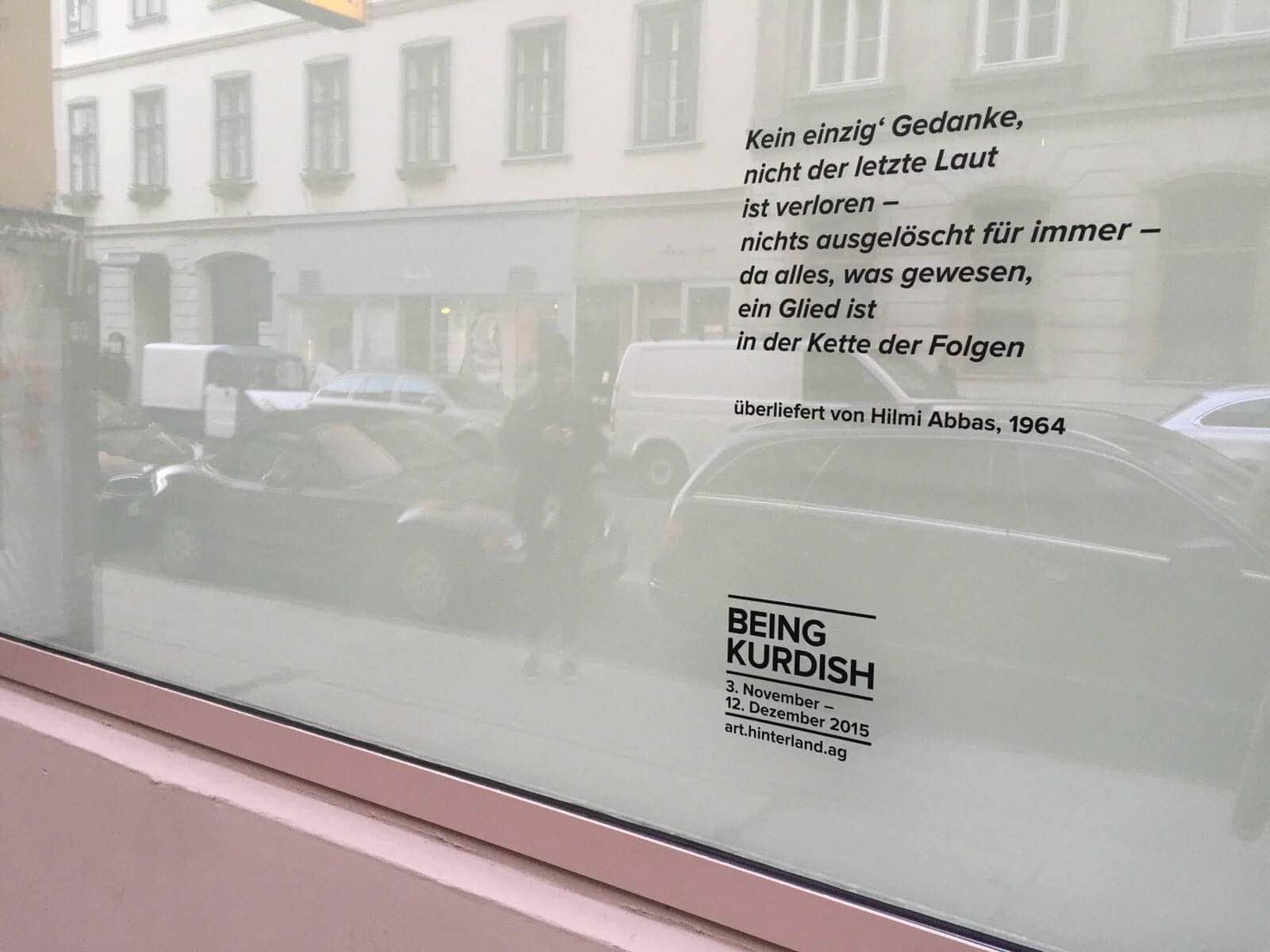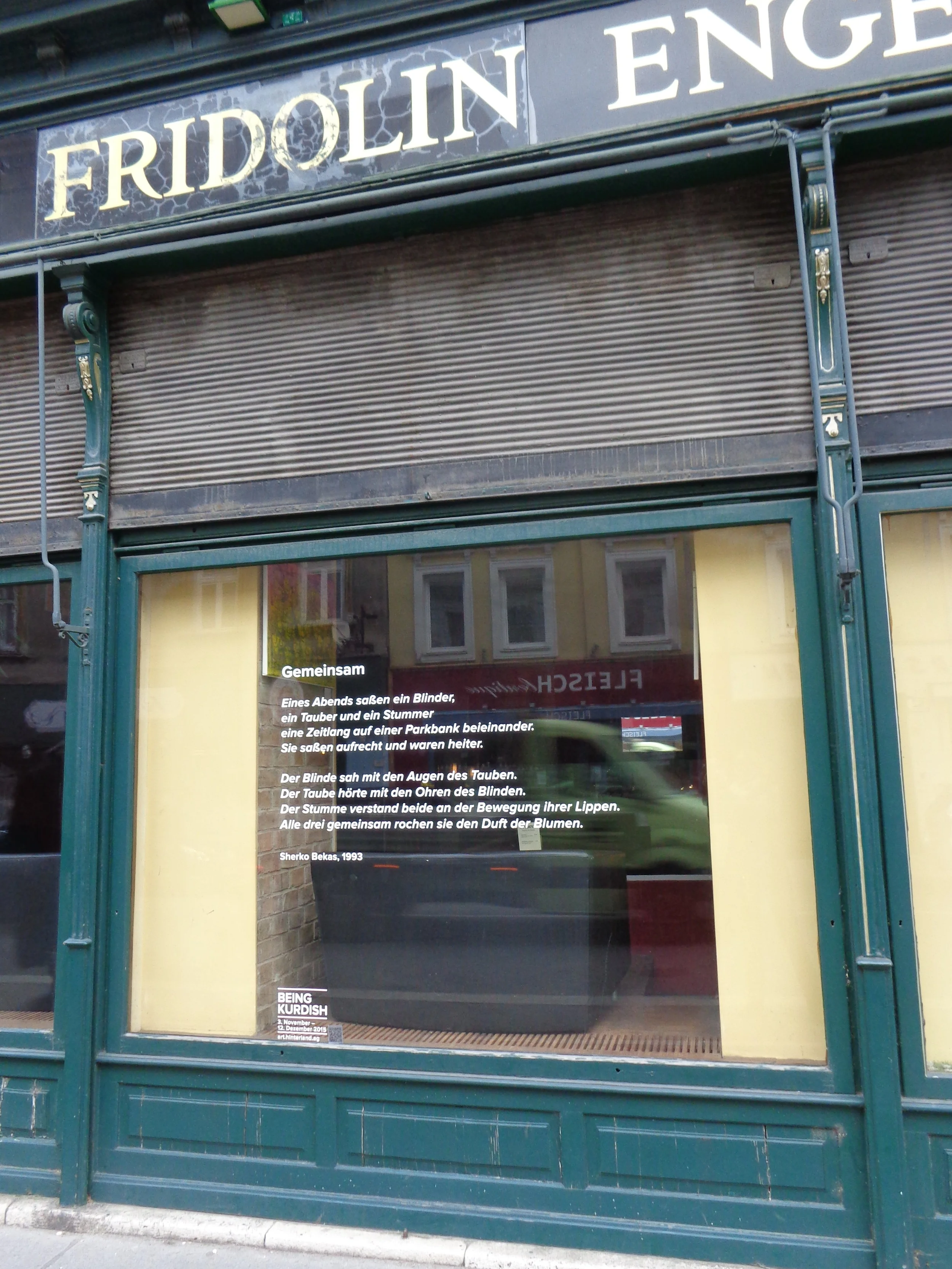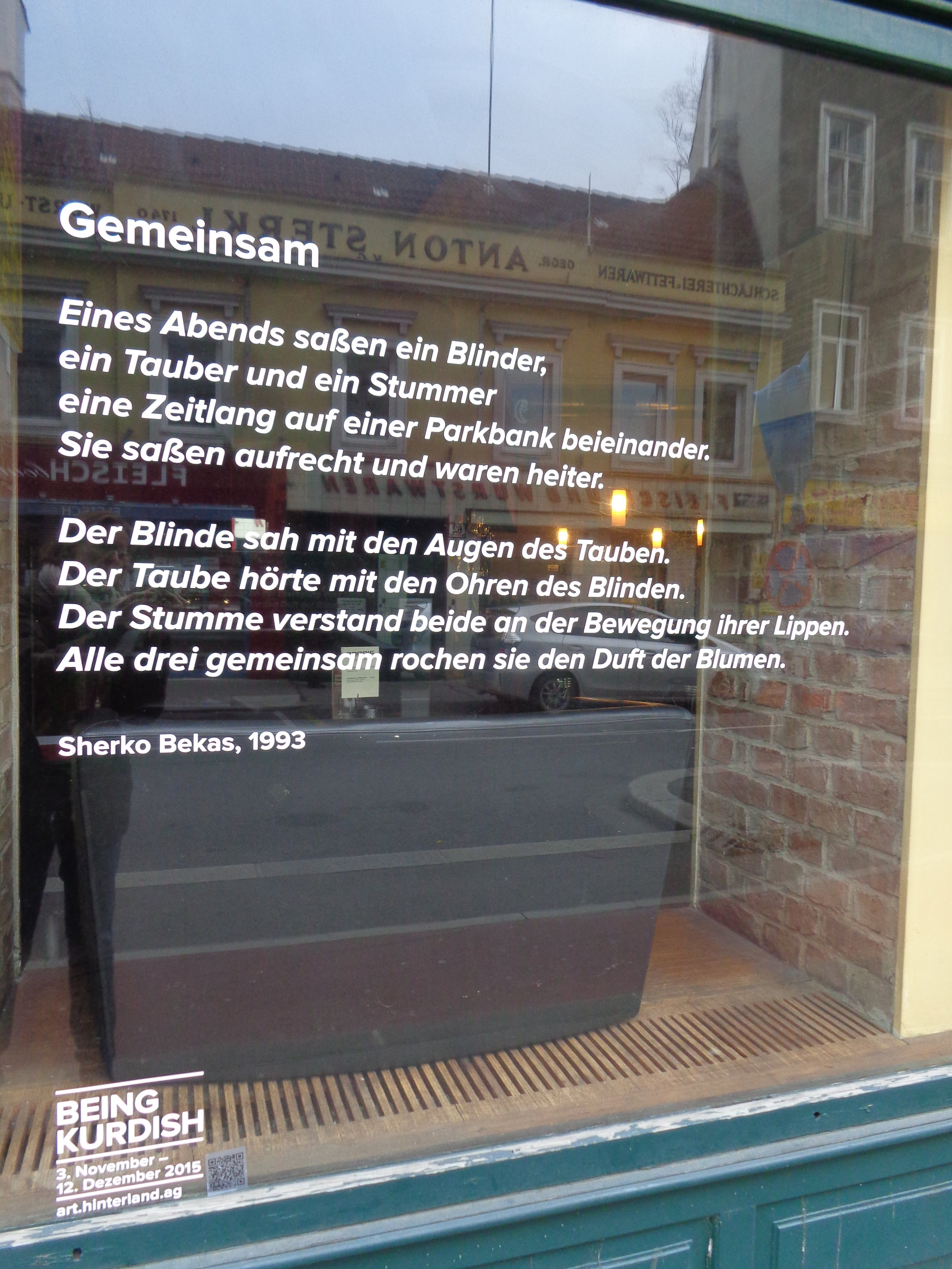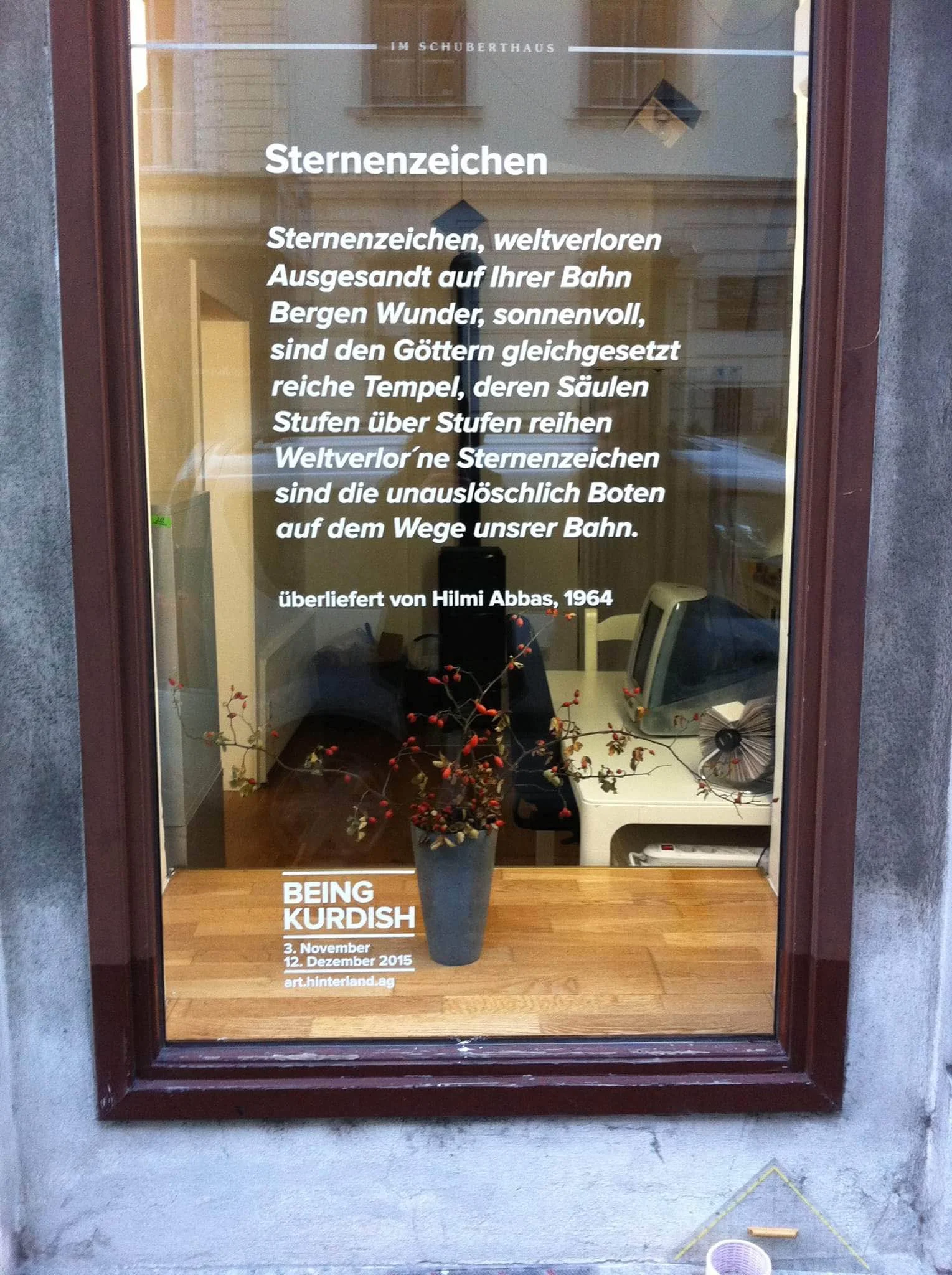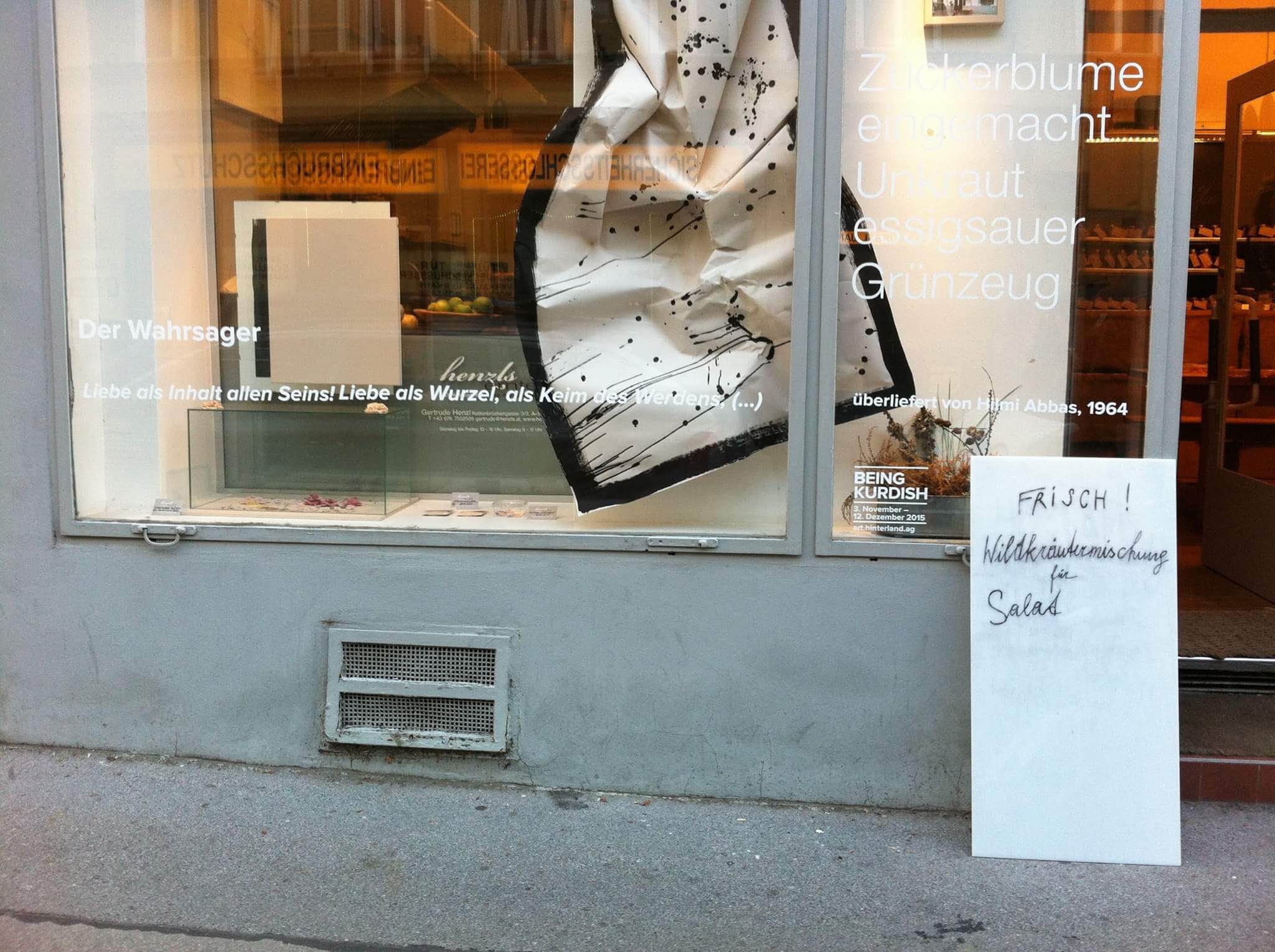LITERATURE IN WINDOWS
November 3 – December 12, 2015
“Songs are chanted sufferings, also happiness”, so says a Kurdish song from the 8th century. In fourteen shop windows in the 4th and 5th districts of the city of Vienna, we present old traditional and new Kurdish poems by Sherko Bekas, Hilmi Abbas-Bei and Ehmedê Xanî. A walk through a Kurdish literature of pain and happiness.
This is not only about literature in windows, not just about spreading words, but particularly about words written by Kurds. On the occasion of the exhibition “Being Kurdish“, an interdisciplinary exhibition with the aim of finding and showing diffe- rent opinions on Kurdish identity, the hinterland gallery partnered up with fourteen shop or office windows to showcase a variety of Kurdish texts.
All the windows are situated in the 4th and 5th districts near the hinterland and Spektakel galleries. It is a cooperative project within these districts.
In order to express different views about this topic through art, the exhibition encompasses videos, textiles, paintings and installations. By making use of this wide variety of artworks in the process of approaching “Being Kurdish”, displaying literature as well was somehow inevitable. Not to mention that searching for the right excerpts for the exhibition was anything but tedious – after reading the first lines of the poems and lyrics, you could feel the emotions sinking in. As Sherko Be- kas, one of the poets, writes: “(...) Für mich gleicht der Kopf eines Nagels dem eines Gedichtes. Beide dringen mit scharfer Spitze in die Tiefe. Der eine durch die Wucht des Hammers. Und das andere durch die Last des Schmerzes”, which means: “For me, the head of a nail is like a poem. With their sharp tips they drill into depth: One with the force of a hammer, the other one through the burden of pain”. Bekas sums up the feeling you get when reading Kurdish poetry.
Love and war are the two main topics. With that being said, it becomes clear why these texts are overwhelming sometimes, making a subject out of the strongest of feelings or circumstances.
With the Kurds as a nationality that has had to deal with conflict and fighting over the years, it is evident why war is one of the main topics. In “Altkurdische Kriegs- und Liebeslieder”, Hilmi Abbas-Bei has preserved old Kurdish lyrics which praise love and mourn the losses of war. Ehmedê Xanî wrote Mem û Zîn back in 1675 and it is considered a national epic. For the Kurds, “Mem“ symbolizes the Kurdish peop- le and “Zîn” the Kurdish country that remains separated by unfortunate circumstan- ces and which cannot be a unity.
In researching this project, it was important to show literature by authors of diffe- rent ages, where each deals or has dealt with their own problems of Kurdish life. The style of writing also differs depending on the year in which they wrote their poems and lyrics.
A large part of this project is the meaning of public space. What does open access display do to the art, in this case to the literature? It is seen. Somehow, people who are passing by are “forced” to read these texts. The idea is that people are confronted with words which, in most cases, they wouldn’t normally read, or simply wouldn’t know about, but now they can see them in everyday surroundings, leading them to new thoughts and provoking an emotional response. People are invited to develop and reflect on their own opinions.
For me, it was important to match the personality of the shop or office to the themes of the poem or lyric in question. The ultimate goal was not only to inspire the people who pass by in the street but also the owners of the shops or offices, in order to allow them to bond or identify with the words they have put up in their windows. Therefore the meaning of the words and the purpose of the shop were coordinated. When talking to these prospective partners for hinterland, some were sceptical at first because the topic of Kurdish identity is a diverse and problematic one. However, getting in touch with the texts quickly changed the minds of our co- operation partners, for those who hadn’t been persuaded in the first place. As the word “identity” plays a major role in this exhibition, if not the biggest one, the idea of community, of sharing thoughts, art and expression while still being individual is channelled through this project of Kurdish literature in windows, giving people a new approach of seeing what “being Kurdish“ is like.
Caroline Ahorner was born in Vienna, and is studying art history at the University of Vienna. She is an author in her spare time and takes a keen interest in social, historical and cultural interest. She started work as an intern at hinterland in 2015, developing her interest in the art of the Middle East.
BIOGRAPHIES
Ehmedê xanî lived from 1651 to 1707. Xanî was a Kurdish writer, scholar and poet. He is regarded as the founder of Kurdish nationalism. In 1683 he wrote a children‘s dictionary in rhymes, entitled Nûbihar, the first Kurdish spelling book for children.
It includes 950 Arabic terms and their meaning in the Kurdish language. His most famous work is the narrative Mem û Zîn, a love story from the year 1692 which also includes a description of 17th-century Kurdish society.
Hilmi Abbas-Bei, born in 1922, is the son of a leading Kurdish diplomat and ori- entalist and an Austrian mother. He studied ancient texts and learned a large part of written Kurdish poetry by heart. He settled in Germany but without denying his background as Ottoman Kurd. He has translated old traditional Kurdish poems, transforming them into German rhymes.
Sherko Bekas was born in Sulaimaniya, Iraq in 1940 as the son of the major Kurdish poet Fayak Bekas. Political persecution by the Iraqi regime led him to leave his homeland in 1981. After living in exile in Sweden he turned back to where he came from – Iraq – in 1992. He died 2013 in Sweden. Berkas takes a leading role in modern Kurdish literature. One reason is the so-called “Ruwanga“ (vision), a new element in Kurdish poetry, which is a deviation from the former, traditional rules of literature, such as rhyme.
The Windows:
COOPERATION PARTNERS
www.feinedinge.at
www.friendlyfire.at
www.unikatessen.at
www.wolfensson.com
www.engels-bar.at
Why not?
www.kannzderoy.com
www.lok-unverbluemt.at
Dr. Kaminski Transporter
www.henzls.at
www.fuergestaltung.at



